THURSDAY
FEBRUARY 28 - 2013
NORE
BARN
11:00 - 12:00 - Tide
rising to high water at 12:51. The stream was already
fairly full when I arrived at Nore Barn. No sign of
the Spotted Redshank, but the Greenshank was feeding
on the shore near the boats. A Common Redshank was
feeding on the shore around the point into the creek.
When I returned to Nore Barn at about 11:45 the stream
was full of water and Spotted Redshank was feeding at
the top of the stream near the small bridge along with
a Black-headed Gull. A couple of visiting birders
arrived at just the right time to see the bird at its
closest.
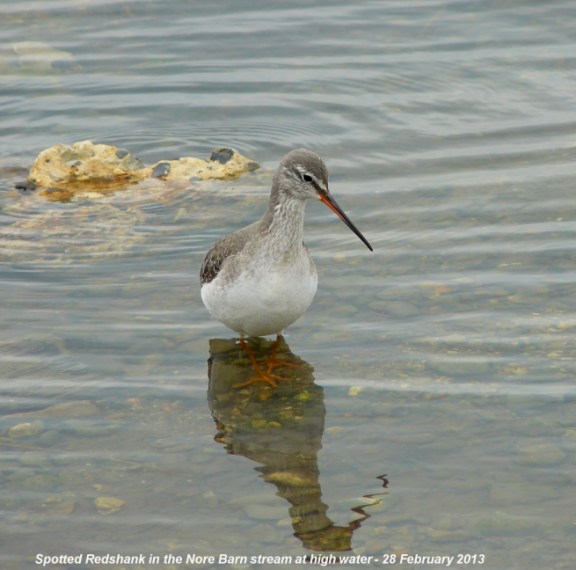
For all the gen on our
local celebrity go to the bird's own web page at . . .
Spotted
Redshanks
Spurting behaviour
As the Spotted
Redshank was nice and close I took lots of photos with
my trusty point-and-shoot Lumix FZ8. Three of the
photos showed the bird apparently spurting out water
through its bill. Here is one of them
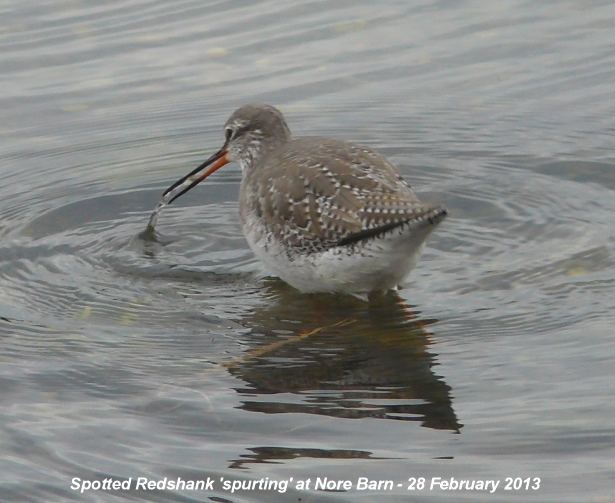
I have mainly seen
this behaviour in Black-tailed Godwits, but it is
clearly fairly common in other waders, including
Greenshank, Spotted Redshank and Common Redshank. What
is surprising is that the wader experts I have
consulted have not seen or heard of this behaviour, or
know why it should happen. In order to resolve this
puzzling behaviour, at the request of the editor of
the Wader Study Group Bulletin, I have written a short
paper on 'spurting' behaviour with photos.
More information and
lots of photos of 'spurting' can be seen on a special
web page at . . .Spurting
behaviour
Brent
Geese
I had a walk along the
path south of the woods from where I could see a
flotilla of about 50 Brent Geese feeding close to the
shore, including the two small families with one and
two juveniles that have been in Emsworth for the whole
winter. Here is the family with two
juveniles.
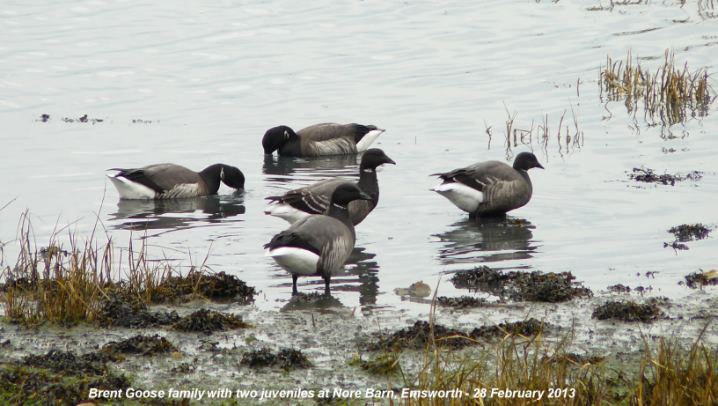
There were also some
Wigeon and Teal but generally Brent and duck numbers
are well down, indicating that many are now heading
back towards their breeding grounds.
Sweet
Violets
The pink form of Sweet
Violets was in flower in the usual area in the western
section of the woods, though not as in such great
abundance as in some previopus years.

Blackbird
song
Blackbird was singing
from a neighbour's garden. I think this is a sign that
they will all be starting their song.
Water
Rail at Baffins
Heather and Derek
Mills found two Water Rails on Baffins Pond this
morning. Here is one of them fanning out its wing.

Glossy
Ibis
Mike Wells went to
view the Glossy Ibis on Warblington Farm this morning.
Good bird, but with the very poor light conditions,
all he managed were aerial silhouettes!

WARBLINGTON
WALK
Peter Milinets-Raby
did his regular Warblington walk this afternoon (12:45
to 2pm), but mistimed the tides, so he had to walk
around Pook Lane first, then ended up at Nore Barn.
Peter was accompanied by John Norton who was showing
off his new camera. The highlights were as follows:
Glossy Ibis, 2 Sandwich Tern (winter plumage) at Nore
Barn, 2 Med Gulls (full summer plumage) Nore Barn,
female Goldeneye off Conigar Point, along with 6
Pintail. Greenshank in the field with the pond,
sitting out the high tide. Their arrival was too late
for the Spotted Redshank. The 'Old Faithful' Curlew in
with the Ibis, was probably the best bird of the walk.
Here is John's photo of the pair. Correction -
Peter actually took this photo!

WEDNESDAY
FEBRUARY 27 - 2013
BROOK
MEADOW
Firecrest
I walked through Brook
Meadow this morning on my way to the shops. Malcolm
Phillips was stationed at the observation fence as
usual, getting very cold. We both had a close view of
a Firecrest with a very bright orange crest
(definitely male) actively feeding in the flooded area
between the path and the car park. They seem only to
have recently discovered this area.
Other
birds
A little earlier I had
a Goldcrest feeding in the Hawthorn bushes by the
small bridge on the Lumley Path. A Wren was also
busily foraging on the edge of the Lumley pool; I
don't recall having seen so many Wrens before on the
edges of the waterways on Brook Meadow. I listened to
a Great Tit singing from a tall Crack Willow near the
north bridge and managed to get this photo of it in
action showing off its bright yellow underparts and
black chest stripe.
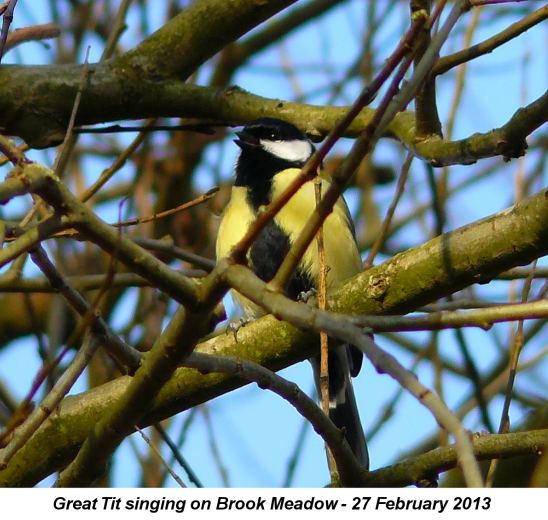
Water
Vole
Maurice Lillie had the
44th sighting of a Water Vole this afternoon north of
'S' bend directly behind the gas holder - west bank of
Ems. The vole plopped into the river and swam
downstream about 8metres, stopping periodically for an
excursion into the bank and back to the river for
another swim.
OTHER
NEWS
Water
Rails on Baffins Pond
J J Goodridge reported
on Hoslist yesterday at least three Water Rails on
Baffins Pond, 2 on the south side and 1 on the east
side, plus 30+ Shoveler and a Cetti's Warbler singing
from the island.
Disappearance
of gulls
Chris Cockburn was
concerned by the mysterious disappearance of
Black-headed and Mediterranean Gulls on Hayling
Oysterbeds. Since about 2008 when Black-headed Gulls
started to dominate the islands in the lagoon, the
site had always been continually busy with territorial
birds from mid-February onwards. All seemed normal
this year until they disappeared around Feb 23rd.
However, the gulls were back on the islands today and
Chris beathed easily again. It seems that the onset of
cold easterly winds and overcast skies starting on 20
Feb was the prime cause. Fine feather warm weather
birds indeed.
Incidentally,
regarding to date when the Black-headed Gulls first
started dominating the islands at Hayling Oysterbeds,
I have an entry in my diary which says . . . "There
was lots of noise coming from the "Tern Island" where
about 200 Black-headed Gulls had taken occupancy,
creating a rather intimidating atmosphere, I would
think, for nesting Terns". I took the following photo
of some of the gulls.
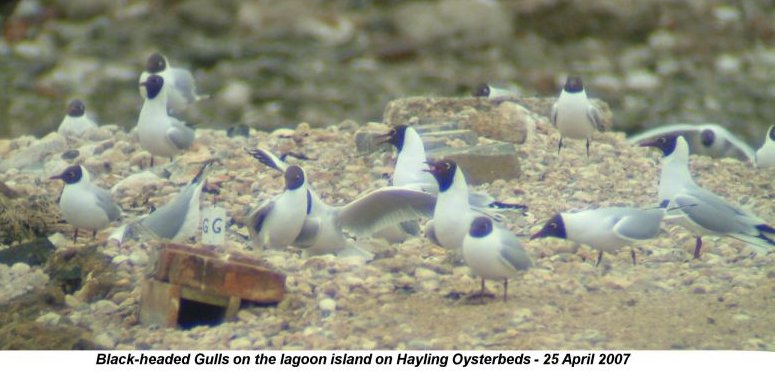
Woodpigeons
invade gardens
The British Trust for
Ornithology reports that over the past decade, Garden
BirdWatch counts of Woodpigeon have risen steadily
year by year and the increase shows no sign of
stopping. Indeed, over the last few weeks their
numbers in gardens have been almost 25% higher than
the same period in 2010-12. See . . . http://bto-enews.org/NXK-1B0RM-3UEDCR-IQD8Z-0/c.aspx
I have also seen an
increase in Woodpigeon numbers in my own garden here
in Bridge Road Emsworth as shown in the following
chart. The increase mainly occurred in the 10 years
from 1998 to 2008 after which there has been a
levelling off. But Woodpigeons are now one of the most
regular visitors to my garden, with up to 7 birds
currently present on and off throughout the day.

The only bird to match
this dramatic increase has been the Goldfinch
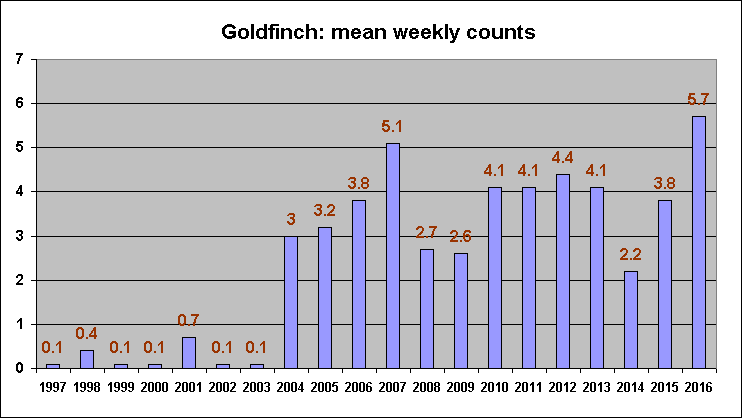
More details about the
changes in the birds visiting my garden over the last
15 years are on the special garden birds web page at .
. . Garden
Birds
TUESDAY
FEBRUARY 26 - 2013
BROOK
MEADOW
Firecrests
- two or three?
I saw my first
Firecrest of the morning at 11.30 in front of
gasholder. I had a very good view of it feeding on the
river bank; the crest was bright orange which makes it
a male.
I then walked quickly
down the path to the sluice gate where Malcolm
Phillips and David Norris were positioned behind the
observation fence on the other side of the river. They
had also seen a Firecrest near the fence, which I
think confirmed the presence of a second Firecrest. I
doubt if the Firecrest I had seen by the gasholder
could have got down to the fence area that quickly.
I walked round to
Palmer's Road Copse where Malcolm, David and I enjoyed
good views of first one, then two, Firecrests in the
flooded area to the west of the path opposite the
observation fence at about 12:00. This could mean
there were three Firecrests on Brook Meadow this
morning, though it is not iunlikely that the one I saw
about 30 minutes earlier near the gasholder had made
its way down to the fence area.
What
sex?
We looked closely for
the colour of the crests, but it was not easy to
decide if they were orange or yellow. Malcolm managed
to get shots of both the Firecrests. The first one
below is clearly male with an orange crest.

The second one has a
slightly less orange crest, thought the overall tone
of the bird is also quite different, whether due to
the photo or the plumage is impossible to tell.
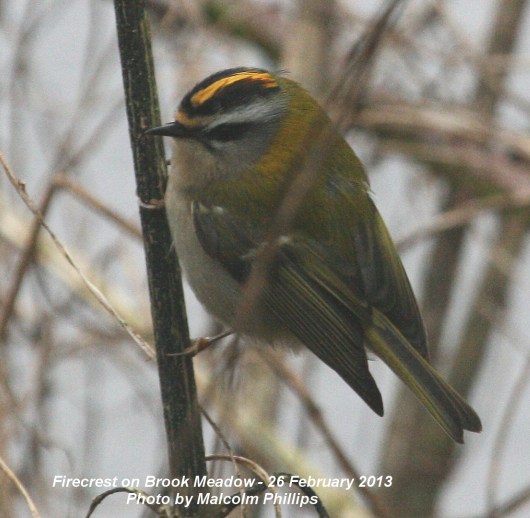
However, if one
compares the two Firecrest photos with the
Goldcrest photo that Malcolm also got at the
same time, then it is easy to see that neither of them
is really yellow. My guess is that the two Firecrests
in Palmer's Road Copse were males, as was the one by
the gasholder.
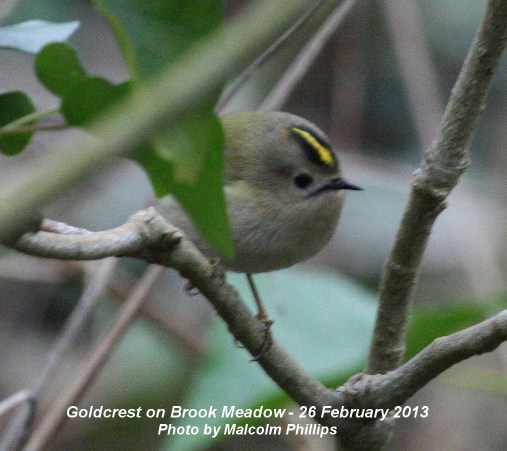
Water
Vole and Brown Rat
Malcolm Phillips saw a
Water Vole north of the north bridge at 10.30am and
also a Brown Rat in the same area.
Italian
Lords-and-Ladies
The marbled leaves of
Italian Lords-and-Ladies (Arum italicum ssp italicum)
are now showing well in the usual spot on the west
bank of the river close to the south bridge.

This plant is
described in The Hants Flora (p.256) as rare. "Planted
for its beautiful foliage and also formerly as an
aphrodisiac. It has escaped into a few shady verges,
hedges and streamsides."
The BSBI New Atlas
describes it as "A rhizomatous perennial herb found as
a garden escape in scrub and shaded hedge banks, often
in places where garden waste is dumped. It sets
abundant seed which is often bird-sown. Lowland.
Neophyte. This subspecies was cultivated in Britain by
1683 and was known from the wild by at least 1905. It
is popular in gardens, and its distribution is
probably increasing. A. italicum subsp. italicum has a
Mediterranean-Atlantic distribution."
Godwit
News
Black-tailed Godwit
L+LL was photographed by Bob Chapman at Farlington
Marshes on Feb 23. See his blog for that day . . .
http://solentreserves.wordpress.com/
Godwit L+LL was ringed at Farlington and has been a
regular in Emsworth Harbour for the past 3 winters,
though I have only recorded it once this winter on
20-Oct-12.
Glossy
Ibis
Ace twitcher Lee Evans
was at Warblington today to see the Glossy Ibis. Lee
also noted 400 Dark-bellied Brent Geese in the field,
with a single Common Chiffchaff (collybita), Curlew
and 8 Long-tailed Tits by the Church Path.
MONDAY
FEBRUARY 25 - 2013
Blackbird
song
A Blackbird was
singing from the gardens of St James Road as I walked
through Bridge Road car park this morning. This was my
first full Blackbird song of the spring, apart from a
short burst from one in the same area (maybe the same
bird?) on Jan 17. They seem to be later starting this
year. In 2012 I heard my first full Blackbird song
from a tree in Chichester Festival car park on Jan 7
and another one in my garden on Feb 8. In 2011, I
heard my first full Blackbird song at the southern
entrance to Hollybank Woods on Jan 14.
Great
Black-backed Gulls
The pair of Great
Black-backed Gulls were on the centre raft of Slipper
Millpond when I passed this morning, one was standing,
the other sitting on what could have been a nest but I
could not see it clearly. This seems very early if it
was a nest.

All
the news and photos of the Great Black-backed Gull
nesting in 2012 and 2013 is now on a special web page
at . . .
http://familyfellows.com/millpond-great-bb-gull.htm
Water
Vole
Ian Mears went over to
Brook Meadow this morning at around 11:30. He saw this
litlle fella in the stream opposite the Water Vole
signcase on the opposite bank where he sat eating.
Then he swam upstream for 10 meters on so before going
into his burrow. Interestingly, Ian's photo shows the
same damage to the fur on the vole's back that we have
noticed before. It was probably caused by fighting.
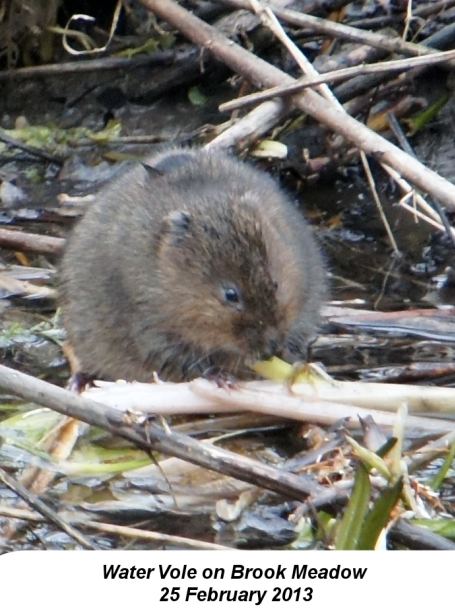
For all the Water Vole
news go to the special web pages at . . .
http://www.brook-meadow.hampshire.org.uk/bm-water-voles.html
Glossy
Ibis
The Warblington Farm
Glossy Ibis had some more visitors today. Chris
Berners-Price wished he had taken his scope with him -
a good point. Ros Norton missed the Havant Wildlife
Group walk on Saturday when the bird was first seen.
Ros also went to Baffins Pond where she got a good
view of two Water Rails on the south side of the pond.
Malcolm Phillips returned for a second look and this
time got really close with some good photos. Malcolm
also saw the Firecrest on Brook Meadow.
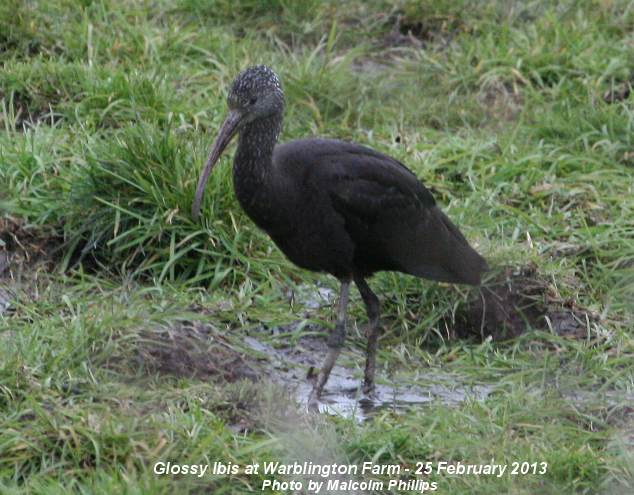
SUNDAY
FEBRUARY 24 - 2013
WARBLINGTON
Warblington
Farm
Another very cold
morning, but the wind was not as biting as yesterday.
I met Malcolm Phillips in the north-east corner of the
Warblington Cemetery Extension at 10.30. Malcolm had
been there for about an hour and had seen the
Glossy Ibis in the field to the east of the
cemetery, where it was seen yesterday by the Havant
Wildlife Group. But all we could see for the next 30
minutes was a Little Egret feeding in the deep stream
on the far side of the field and a single Curlew which
is a regular on this field.
Here
is Malcolm's photo of the Little Egret displaying its
beautiful plumes

Malcolm
also captured the 'resident' Curlew which was feeding
in the field much closer to us

A few other
birdwatchers turned up, including Helen, who was the
first to spot the Ibis as it emerged from hiding at
about 11:00 to feed on the wet field. It was a nice
relaxed atmosphere, not at all like a serious twitch.
I took some digiscoped photos then Malcolm and I left
for a warm cup of coffee at home.
Here
is my digiscoped Glossy Ibis showing the speckled neck
and curved Curlew-like bill
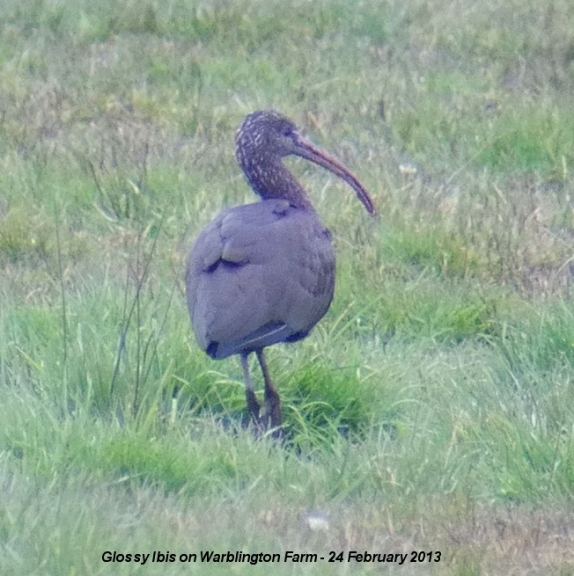
The white speckling on
the bird's head and neck indicates the non-breeding
plumage. The bird is about the same size as the Little
Egret. A chap who had seen the Glossy Ibis at
Bickerley Common in early January thought this was not
the same bird as the speckling was more extensive.
Birds of the Western Palearctic states that Glossy
Ibis is migratory and dispersive, with considerable
nomadic element, which probably explains why this chap
is so far away from home.
BROOK
MEADOW
Water
Voles
From Warblington,
Malcolm Phillips went onto Brook Meadow where he saw a
Water Vole about 15 yards up river from the sluice
gate. Interestingly, Malcolm's photo shows damage to
the fur on the animal's back, which is probably the
result of fighting.

Stephanie Williamson
visited Brook Meadow this morning at around 11am and
also saw a Water Vole in roughly the same place as
Malcolm did a couple of hours later. It was among the
flooded vegetation on the west bank, hopped into the
stream and swam a few metres downstream,
'deliberately' climbed over a fallen branch (scent
marking?), back into the water, then hopped into the
ivy undergrowth.
Water
Rail
Stephanie and Malcolm
also saw the Water Rail in the same general area.
Stephanie watched the Water Rail for 5 mins which was
completely unphased by passers by.
Firecrests
Stephanie also enjoyed
seeing a male Firecrest, at the water's edge on west
bank just south of the old gasholder, foraging a few
inches above the water and displaying almost
hummingbird-like hovering behaviour close to vertical
stems and branches. Then just south of the north
bridge she saw the female Firecrest, foraging but not
'hovering'.
Malcolm also saw what
looks like a female Firecrest from his photo - with a
yellow crest. This is the third sighting of what we
think is a female Firecrest though it is always a
little risky drawing conclusions about colour from a
photo.
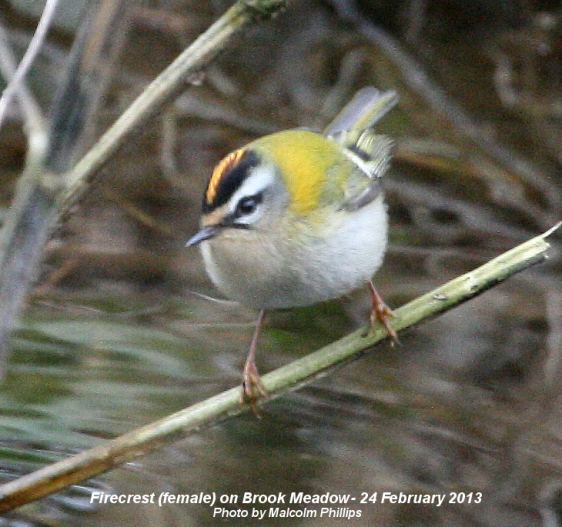
SATURDAY
FEBRUARY 23 - 2013
NORE
BARN - WARBLINGTON
Heather Mills reported
on this morning's walk by the Havant Wildlife
Group.
For the full report go
to . . hwg-walk-reports-2013
Glossy
Ibis
The
group had a most exciting sighting of a Glossy Ibis on
Warblington Farm.
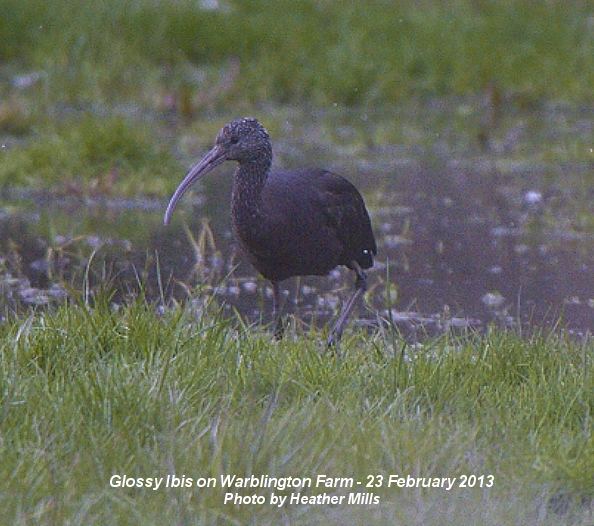
Glossy Ibis is a very
rare vagrant in Hampshire. It is basically a
Mediterranean Bird. I have only ever seen them in
Mallorca and Greece, though there was one at
Farlington Marshes in June 2012 which Peter
Milinets-Raby photographed. There were only four
sightings Glossy Ibis reported in the Hampshire Bird
Report for 2010. There were no sightings on Hoslist in
February. One was present from 1-15 in January at
Bickerley Common SU1404 near Ringwood.
Ralph Hollins
comments: What a super record for the Warblington
Farm. In case people are not aware Ibis seem to be
very scarce in Britain at the moment - up to Jan 15
there was a regular at Bickerley Common (in the Avon
Valley just south of Ringwood) but it seems to have
flown south to Christchurch Harbour on Jan 16 and then
disappeared. The only other south of England report
since then was of one at the Breech Pool behind the
north wall of Pagham Harbour on Feb 18, seen by Trevor
Carter, and I only heard of that as Trevor reported it
to John Goodspeed and the news never got on the Sussex
Ornithological Soc website presumably meaning that it
did not stay in that well watched area. Currently the
only one being regularly seen (and appearing on the
Rare Bird Alert - RBA -website) is in Pembrokeshire.
In the first two months of 2012 there were quite a few
roaming the British Isles with a UK total of 30 (23 of
them in Pembrokeshire) reported by RBA on Feb 2 and a
flock of 5 in Norfolk on Feb 23 and on May 28 and June
5 one was at Farlington Marshes (staying until June 16
and re-appearing on Aug 11) before the long stayer
into this year arrived at Bickerley Common on Dec
2.
Just in case no-one on
the walk has reported it to HOS I will send a message
to Hoslist so that other birders can keep an eye open
for it in Hampshire though I do not expect it to
remain here (there's a lot of early spring movement
going on at the moment). The Glossy Ibis was in the
field east of the new Cemetery Extension (which is
east of the Church). The map ref is around SU 731 054
Other than one reported by RBA in Pembrokeshire this
appears to be the only one currently in the south of
England.
BROOK
MEADOW
Malcolm Phillips went
round the meadow this morning and saw the Firecrest
and a Goldcrest. He was just on his way home when he
spotted a Water Vole by the sluice gate,

FRIDAY
FEBRUARY 22 - 2013
EMSWORTH
I had my regular walk
around Brook Meadow and the Hermitage Millponds on a
cold morning with an easterly wind that felt like it
came from the Urals.
Grey
Wagtail
A Grey Wagtail was
active beneath the south bridge. The photo suggests a
female from its buff-white throat and the yellow on
the breast shows it is coming into breeding plumage,
so it is probably the same bird that I saw here on Feb
20.

Malcolm's
vigil
Malcolm Phillips spent
3 hours round the meadow getting very cold with
nothing very exciting to report. Golly, these
photographers really suffer for their art! Malcolm did
manage to find the Firecrest in the north west corner
of the meadow near the railway embankment (the first
sighting here since Jan 19), but did not get a good
photo. However, he got some cracking shots of some of
our resident birds, including a Robin, Dunnock, Wren,
Long-tailed Tit, Chaffinch and Malcolm's first ever
Greenfinch on Brook Meadow.
Here
is Malcolm's Greenfinch in song

I just
could not resist this Long-tailed Tit
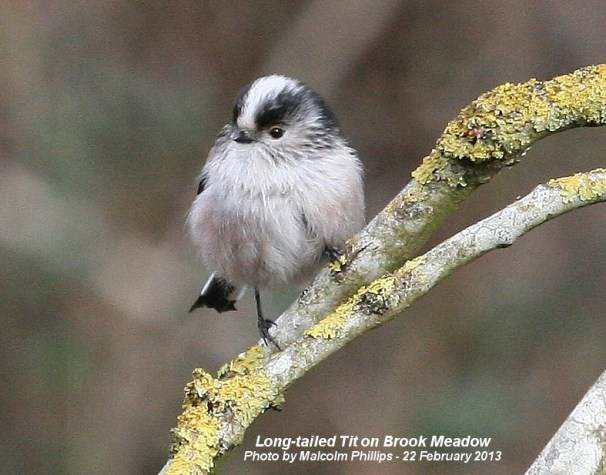
Water
Vole
Annabelle Parker
phoned me this afternoon to say she and her children
had just seen a Water Vole on the river bank from the
south bridge at 1pm. That was the 38th sighting of
2013.
Great
Black-backed Gulls
The pair of adult
Great Black-backed Gulls was on the centre raft of
Slipper Millpond this morning. These two adults have
been regular visitors to Slipper Millpond over the
winter. I could not see any signs of a nest, but their
intention is clearly to nest on the raft again for the
second year running.

Lichen
on Ash sapling - Xanthoria parietina
?
I stopped by Peter
Pond to admire the abundant growth of a yellow foliose
lichen on a Ash sapling on the south bank by the main
road. This lichen has numerous jam tart-shaped
fruiting bodies and broad lobes which resemble the
white of a fried egg.

My tentative
identification is Xanthoria parietina
This lichen is very common throughout Britain, on
nutrient-enriched bark and stonework, often abundant
on coastal rocks, increasing as a result of
nitrate/ammonia deposition from atmospheric pollution.
http://www.lichens.lastdragon.org/Xanthoria_parietina.html
Peter's
Warblington walk
Peter Milinets-Raby
did his regular walk from Nore Barn (07.45) along the
shore to Warblington, up Pook Lane and then headed
back on the Solent Path past Warblington Church. He
saw 2 Greenshank, a Spotted Redshank and 2
Black-tailed Godwits in he Nore Barn stream and
another Spotted Redshank in the field with the pond at
the end of Nore Barn Creek. 12 Reed Bunting were
feeding in the tidal marsh at Conigar Point. A Greylag
Goose was amongst the Brent on Nore Barn, then flew
off over the town of Emsworth. 6 Bar-tailed Godwits at
Conigar Point along with 95 Dunlin and 2 Grey plover.
18 Pintail at the point. 2 Buzzards. Peter's photo of
Brent Geese and Wigeon relaxing on the tide at Nore
Barn shows one juvenile Brent with very faint white
wings bars.
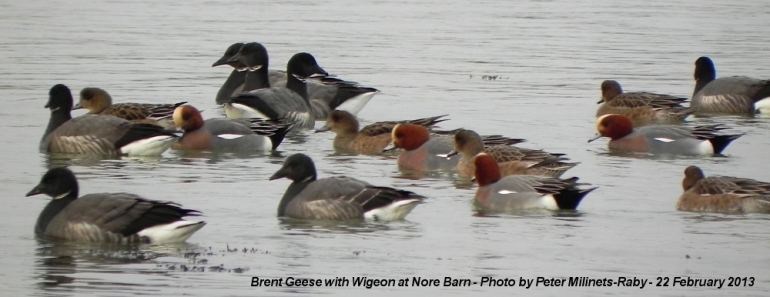
Greenshank
'spurting'
Peter came across a
colour-ringed Greenshank on the shore at Pook Lane.
Peter recorded the rings as, Left: Red-Green Right:
Yellow. This is probably RG+YY which we last saw in
Emsworth on 18-Dec-08. This record should go to Anne
de Potier.
Of more interest to
me, Peter observed this Greenshank 'spurting' as it
grabbed a big wiggly worm and spurted the water out.
Peter added, "I observed the Greenshank at very close
quarters and to me all the bird did was force out the
water and sand granules that it had taken down with
the wiggly flat worm into it's gullet. The Spotted
Redshank does the same after feeding for two three
minutes, taking in food, sand particles and excess
water into the gizzard/gullet and just like
regurgitating food for youngsters it spurts out the
water and particles it does not want. Just like an Owl
or a Shrike with its pellets".
I wish Peter would
tell the experts this as they say they have never come
across this behaviour and cannot understand it! For
more information and photos on the 'spurting'
controversy see . . Spurting
behaviour
THURSDAY
FEBRUARY 21 - 2013
BROOK
MEADOW
Conservation
work session
I went over to the
meadow this morning to take photos of the conservation
work session. A good crowd turned up on a very chilly
morning. They were mainly engaged in spreading wood
chippings that the council had left onto the very
muddy path through Palmer's Road Copse. Here are a
couple of volunteers raking the chippings on the path
through the copse.
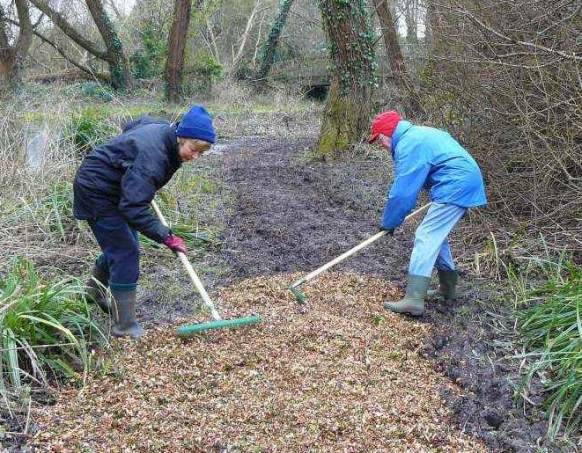
Water
Rails
Malcolm Phillips
reported two Water Rails at 10am this morning. One
flew from the west bank to the east bank of the river
south of the observation fence (also seen by Lesley
Harris). The other was seen by Malcolm in the open
area north of the fence. This was our first sighting
of two Water Rails on Brook Meadow, though it reminded
me that five had been seen on Baffins Pond on Feb 19th
by R Tofts (reported on Hoslist). It looks as if we
could have quite a few moving through the area at
present.
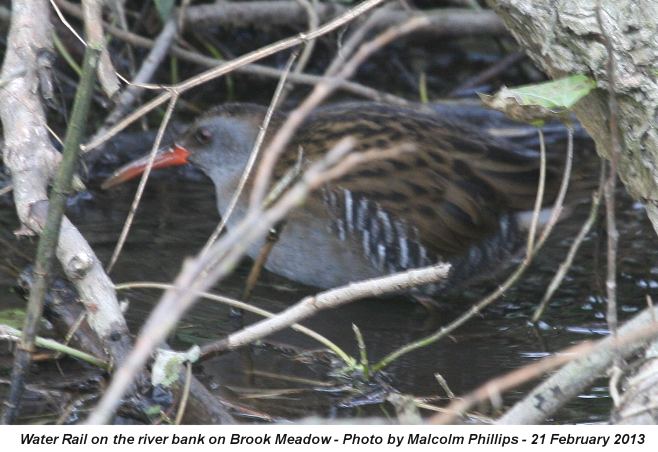
Water
Vole
Malcolm did not manage
to find his friendly Firecrest today, but did get a
brief glimpse of a Water Vole north of the north
bridge.
Frog
spawn
I was alerted to the
presence of some Frog Spawn in the small pool behind
the sluice gate leading into the south meadow. This
was the first of the year seen on Brook Meadow.

Winter
flowers
There are quite a
number of Butterbur buds are opening on the
embankment below the main seat on the meadow, some
with pale pink petals showing.
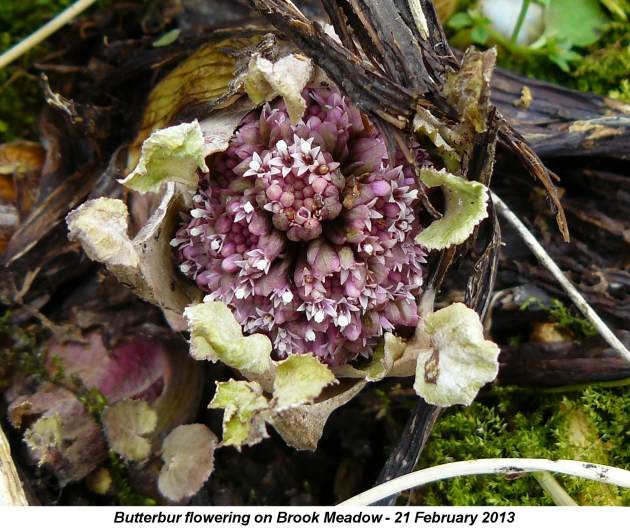
A small patch of
Snowdrops are flowering below the Alder
Buckthorn plantation on the south meadow. I had not
noticed these before.
Lichen
- Amandinea punctata ?
There is a good growth
of a crustose lichen on the trunk of a young Oak tree
on the east side of the north meadow. Its thallus
consists of a number of thin crusts arranged roughly
horizontally on the bark of the tree varying in colour
from pale to darker grey. The darker crusts have a
number of spaced, almost black, rounded fruiting
bodies (apothecia) and the lighter crusts have pale
cup-shaped fruiting bodies. Assuming I am looking at
one species of lichen on the tree, these presumably
are different stages in the development of the lichen.
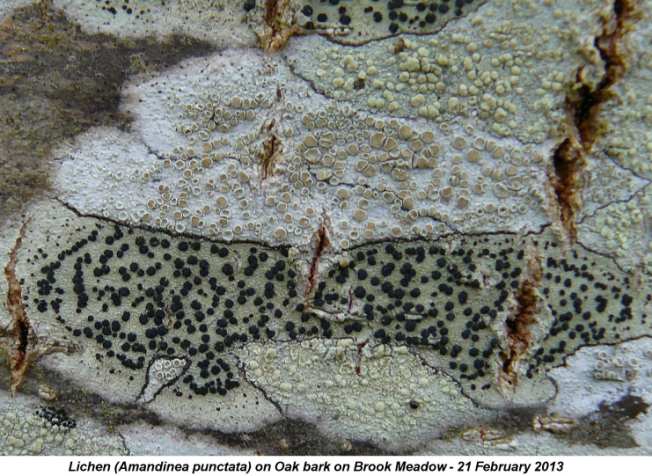
From the National
History Museum Guide to Lichens on Twigs I have
tentatively identified this lichen as Amandinea
punctata See . . . http://www.nhm.ac.uk/nature-online/life/plants-fungi/lichen-id-guide/index.dsml
This lichen is
described as . . . "A widespread lichen on
nutrient-rich bark and wood, also found on nutrient
enriched rocks and debris. Tolerant of pollution and
inorganic fertilisers. Very variable. Thallus pale to
dark grey, inconspicuous, thin or thick, prothallus
rarely present. Numerous flat to slightly convex,
small black apothecia with thin margins. Pycnidia are
sparse." Possible alternative - Arthopyrenia
antecellans
For more on lichens go
to special lichen news page at . . . Lichens
OTHER
NEWS
Intermediate
Periwinkle
Ralph Hollins found
what he thinks is Intermediate Periwinkle - a garden
form not wild. Ralph's photo shows that this species
has the 'propeller blade' petals with gaps between
them, but the flowers are very pale compared with the
vivid violet/mauve colour of the Greater Periwinkle
var Oxyloba which also has 'propeller blade' petals.
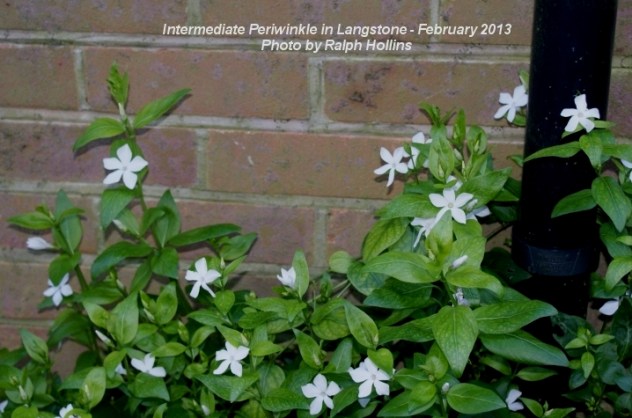
If you want to see it
go to the main road to Hayling through Langstone and
park in the layby roughly opposite Langstone High
Street, then walk west along the footpath leading to
Mill Lane. The plants grow against the wall of the
house which is on your left as you meet the roadway
which is Mill Lane.
Bob
Chapman
My apologies to Bob
Chapman for referring to him in yesterday's entry
simply as 'Warden of Farlington Marshes'. In fact, he
is now the East Solent Reserves Officer and is
responsible for Southmoor, Swanwick Lakes, Pewit
Island (in Portsmouth Harbour), Hookheath and
Catherington Down as well as Farlington.
Findhorn
News
Richard Somerscocks
reports from Findhorn in northern Scotland with some
more excellent photos, including a drake Common
Scoter, a Guillemot on the shore, Tree Sparrows which
we never get down here along with some lichen.
All Richard's reports
and photos can be seen on a special Findhorn News page
at . . . Findhorn
News
WEDNESDAY
FEBRUARY 20 - 2013
SOUTHSEA
Purple
Sandpipers
Jean and I had a
stroll along Southsea prom this morning. We found 8
Purple Sandpipers on the concrete shore in front of
the Castle, mostly very well hidden among the seaweed.
A passing helicopter put them all up so we were able
to do an accurate count. I tried taking photos, but
the light was poor and a freezing easterly wind was
blowing. This was my best effort.
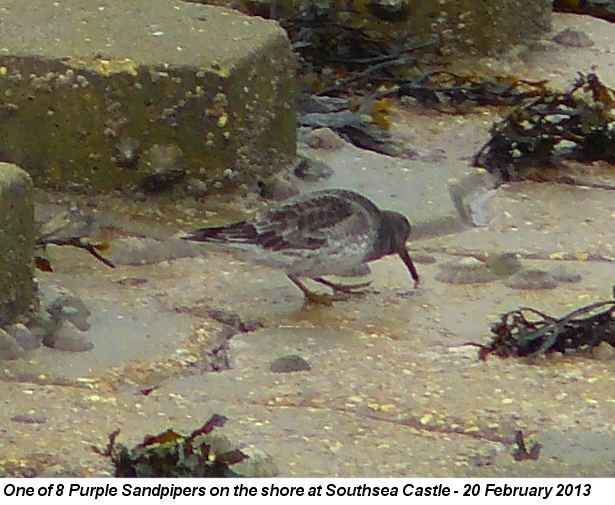
Purple Sandpipers
breed mainly in Iceland and Scandinavia, though some
go further north to the Arctic. They are very scarce
winter visitors to our coastline, but Southsea Castle
is by far the best place to see them in Hampshire. I
think over 20 have been recorded on occasions, though
my best total was 15. They are well camouflaged among
the seaweed on the rocky foreshore and are not easy to
see at first.
A Rock Pipit
was feeding higher up on the shore, but flew
before I could get a photo. Also, on the shore were 5
Oystercatchers.
BROOK
MEADOW
Water
Rail
Maurice Lillie had the
good fortune to get a good view of our very elusive
Water Rail in the sunshine yesterday morning (Feb 19)
at about 09.15am. It was in an open space on the west
bank 20 metres or so south of the 'S' bend up to its
knees in the slack water. Maurice watched it feeding
and preening for a little while, before it turned and
strode off out of sight into the piles of branches and
twigs.
Grey
Wagtail
I had a walk through
the meadow this afternoon, looking for the Water Rail
that Maurice Lillie saw yesterday, but there was no
sign of it. However, I was compensated by geting a
good view of a Grey Wagtail feeding on the west bank
of the river north of the south bridge. The bird's
buff-white throat indicates it is a female and from
the yellow on the breast it is coming into breeding
plumage. This bird is probably 'resident' in this area
as we have had several sightings this year. So maybe
it will breed on the meadow, if it finds a mate.
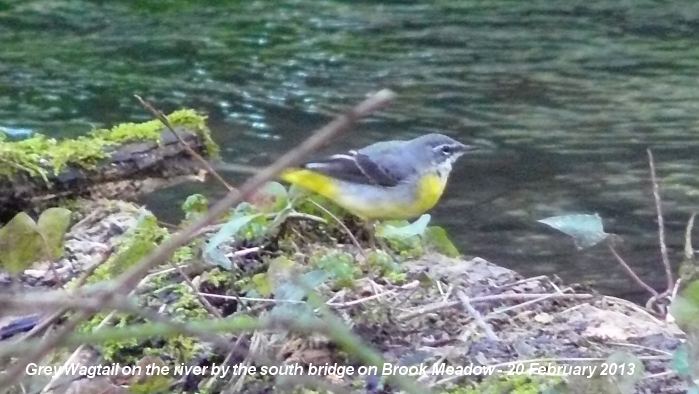
Firecrest
Malcolm Phillips only
managed 20mins around the meadow today from 2pm, but
still managed to find and get this superb photo of
what I think is a male Firecrest in Palmer's Road
Copse. How does he get shots like this?

Malcolm
also captured this image of a Blue Tit coming in to
land.
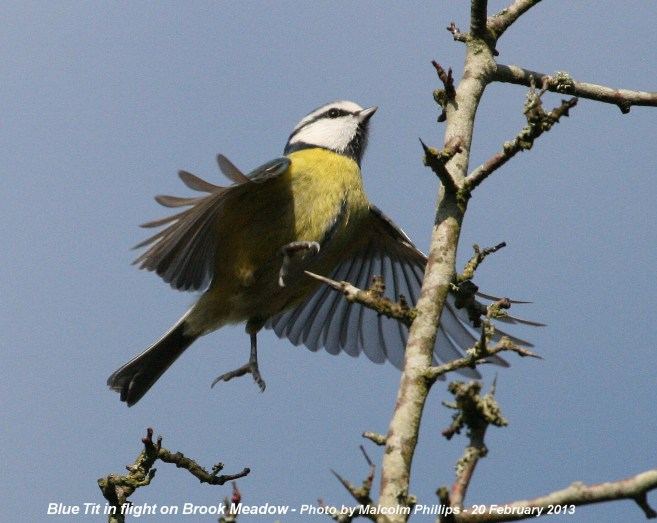
Sandbags
Maurice Lillie reports
that the white sandbags that had been placed on the
curved retaining wall in the northeast corner of the
meadow presumably as a flood precaution have been
thrown into the river. Maurice has spoken to the Fire
Brigade and to Havant Borough Council who think it is
the responsibility of the Environment Agency to clear
the bags. Meanwhile, the bags are lying at the bottom
of the fast flowing river.
FARLINGTON
MARSHES
I can highly recommend
Bob Chapman's blog for all the news from Farlington
Marshes reserve, where Bob is back as warden after a
few years away at Blashford Lakes. Yesterday, he was
pleased to find a Bittern sun bathing in the reedbeds
near the building and took some good photos, which you
can see on the blog. He also heard 4 Cetti's Warblers
and 4 Bearded Tits. Go to . . . http://solentreserves.wordpress.com/
TUESDAY
FEBRUARY 19 - 2013
Red
Admiral
The butterfly that I
rescued from a bucket of water yesterday and brought
into the house was still alive after spending the
night under a cover. This morning I transferred it to
a small cardboard box and took it outside. When I
opened the box it stretched its wings and flew off
into the winter sunshine! That made me feel really
good, to think I have saved one fellow creature, at
least for a short while. It had done really well to
survive this long.
This
is where I first found it on the garden path
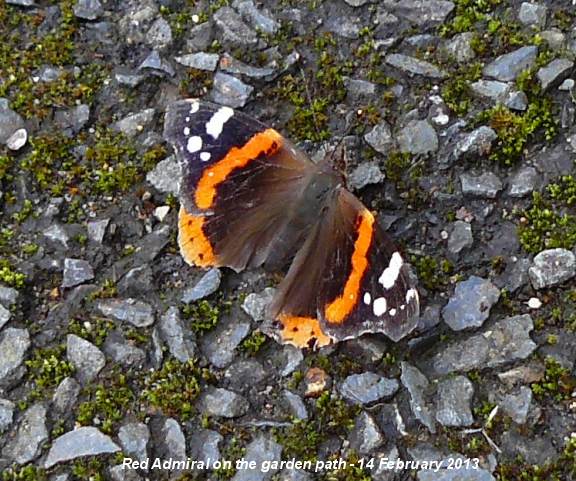
Red Admiral has a
strange life history. It is strongly migratory and the
British population depends almost entirely on the
immigration each year from the Continent as very few
adults manage to survive the winter. The first major
influxes are in late May and early June. The females
arrive already mated and it is their offspring that we
see in summer and autumn. There is some evidence of a
return migration, though many try to hibernate, often
in quite exposed places. Most of these will perish,
but their hibernation is not complete and like the one
I found are liable to 'wake up' on warm winter days.
So, Britain is in a sense a dead end for this species
as they go no further.
This is presumably an
evolutionary push towards expansion of range. Recent
studies of over wintering behaviour has shown that all
four stages may be found in Southern England. Eggs and
larvae are sometimes able to pass a complete winter
and sometimes hatch in the spring, but the adults are
usually much weaker than the immigrants.
There are four other
UK butterflies that hibernate as adults: Brimstone,
Small Tortoiseshell, Comma and Peacock. Small
Tortoiseshell and Peacock regularly over winter near
or inside human habitation, in lofts, outbuildings,
cool rooms, etc. Brimstone and Comma hibernate in
woods, deep among evergreens such as Holly and Ivy.
Firecrests
I was in Palmer's Road
Copse at around 3.30pm and saw two Firecrests feeding
in the large ivy bush to the south of the observation
fence. I am fairly sure both of them were males with
bright orange crests. There was also a Goldcrest
feeding further south along the river, but much higher
in the Crack Willow trees.
Chaffinch
song
While watching the
Firecrests in Palmer's Road Copse, I heard my first
Chaffinch song of the year. Another new song heard
this afternoon was a Stock Dove calling from Lumley
Mill Farm.
Wild
flowers
There is a good
display of spring flowers on the roadside verges along
Lumley Road, including Snowdrops, Sweet Violets and
Lesser Celandines. I also noticed a single flower
spike of Grape Hyacinth (a common garden escape).
Ralph Hollins also discovered one on Havant on Feb 11.
Just one (not so wild) Wallflower was also out on the
wall of Inholmes Cottage, north of Lumley Mill.

Red-breasted
Goose
Ralph Hollins found a
Red-breasted Goose on the mudflats in front of the
Royal Oak pub at Langstone at 5pm this evening. Ralph
says, "There were a few Brent in view but the
Red-breasted was on its own with its back end towards
me. The black and white pattern I could see was
clearly not that of a Brent and as I was wondering
what it was it turned its head sufficiently to show
the distinctive red of its breast and neck." This
could be the same bird that has been around Farlington
and Thorney Island for several weeks.
Ralph
apologises for the dreadful photo.
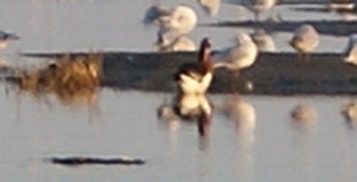
This
might help to see what it should look like

MONDAY
FEBRUARY 18 - 2013
Odd-looking
Brent
Tom Bickerton was out
photographing Brent families on Saturday (Feb 16) at
Farlington, when he came across this rather
sad-looking individual. Talking to Bob Chapman (who
has returned as Warden of the reserve) and Chris
Cockburn (RSPB Volunteer Warden), Tom learned that the
goose was about 10 years old. One can't help feeling
sorry for the old guy, as Tom said, he didn't seem to
have a mate, plus he was being pecked by the family
groups. There is no hybrid in the bird's plumage, so
the speckling must just be a generic disorder.
Interesting looking bird though.
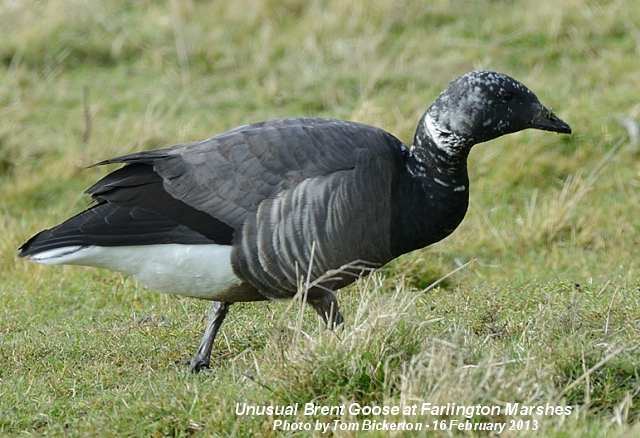
Red
Admiral
This afternoon, my
wife discovered a Red Admiral floating in a bucket of
water in the back garden. It was still alive, so we
fished it out and brought it inside to dry off. It
looks like the same insect that I rescued from the
garden path on Feb 14 and placed it on the ivy hedge
from where it must have flown into the bucket.
Firecrest
Ros Norton saw a
Firecrest at 1pm today flitting around the bushes near
the observation fence at Brook Meadow.
SUNDAY
FEBRUARY 17 - 2013
Lichen
on Elder on Brook Meadow
There is a dense
growth of yellow foliose lichen on the bark of the
dead Elder tree on the main river path opposite the
Bulrushes.
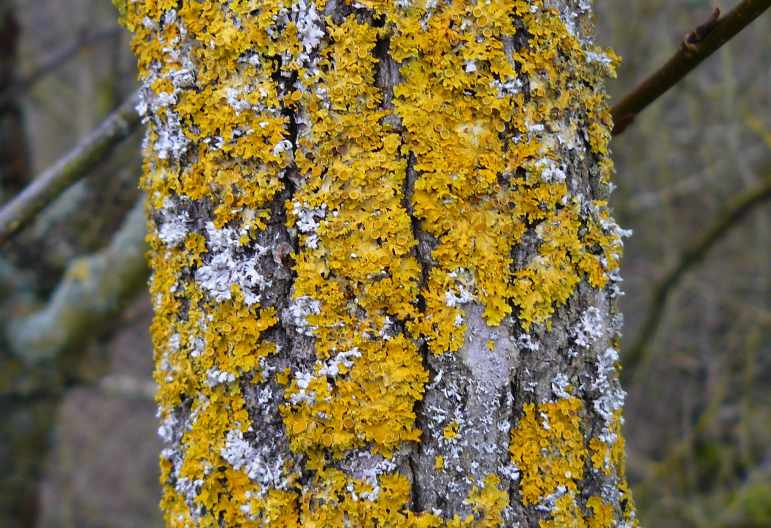
My tentative
identification is Xanthoria parientina
which shows the distinctive cup-like fruiting bodies
under the microscope.
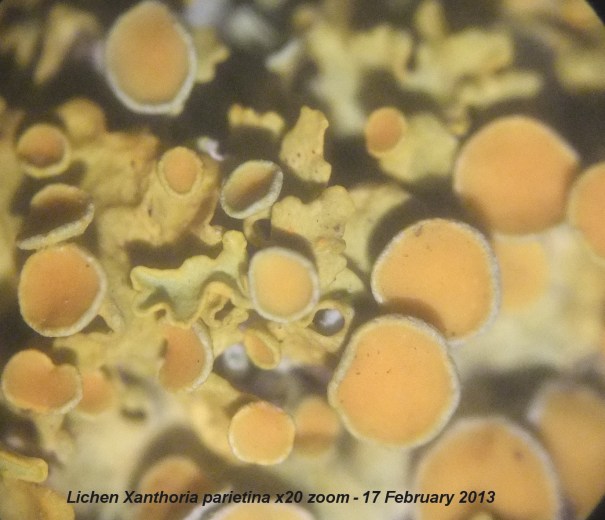
Alder
flowers
Alders on Brook Meadow
are now showing this year's male and female catkins;
the male ones are yellowish and hang down like Hazel
catkins, the female ones are smaller, red and erect,
and will eventually develop into cones. The trees also
have last year's gnarled cones.
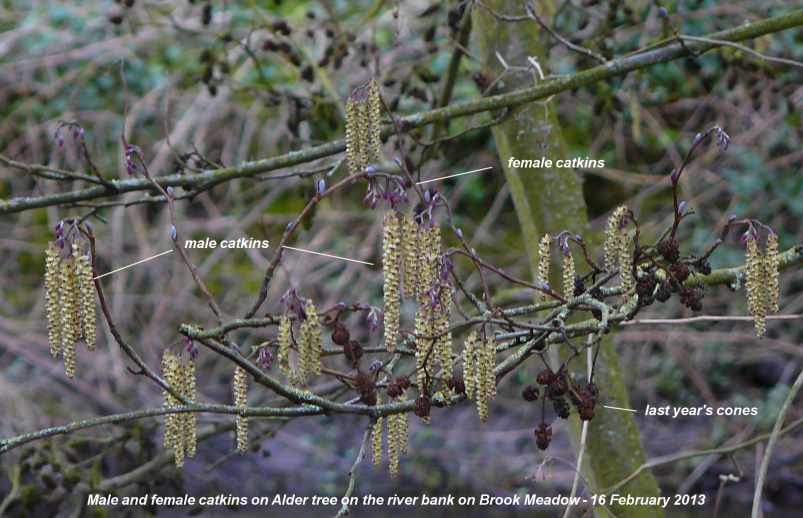
Gorse
on Slipper Millpond
Two Gorse bushes in
full blossom on the east bank of Slipper Millpond were
looking magnificent in the sunshine. A Little Grebe
was fishing on the pond, but nothing else of interest.
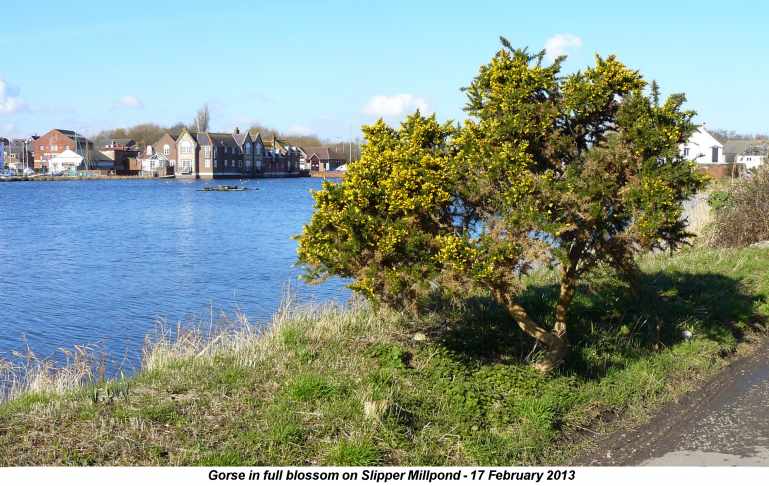
Hayling
Billy Line
Chris Cope reports on
the Saturday morning walk by the Havant Wildlife
Group.
Go to . . .
Havant
Wildlife Group
Water
Rails on Baffins Pond
Eric Eddles went for
his regular morning walk around Baffins Pond and was
thrilled to see not one but a pair of Water Rail. This
could be a first for the pond?
Unusual
Wren behaviour
Malcolm Dixon was told
by a friend about a Wren sitting on the back of a
Woodpigeon and pecking at the back of its neck for a
few seconds. He says, both birds were aware of the the
event and accepted it. Anyone heard of anything
similar? (reported on Hoslist)
SATURDAY
FEBRUARY 16 - 2013
Gorse
flowers
Walking around
Emsworth today I could not help but admire the
splendid blossom on the Gorse bushes. There is a good
one flowering on the causeway on Brook Meadow and an
even better one on the south west corner of Peter
Pond.
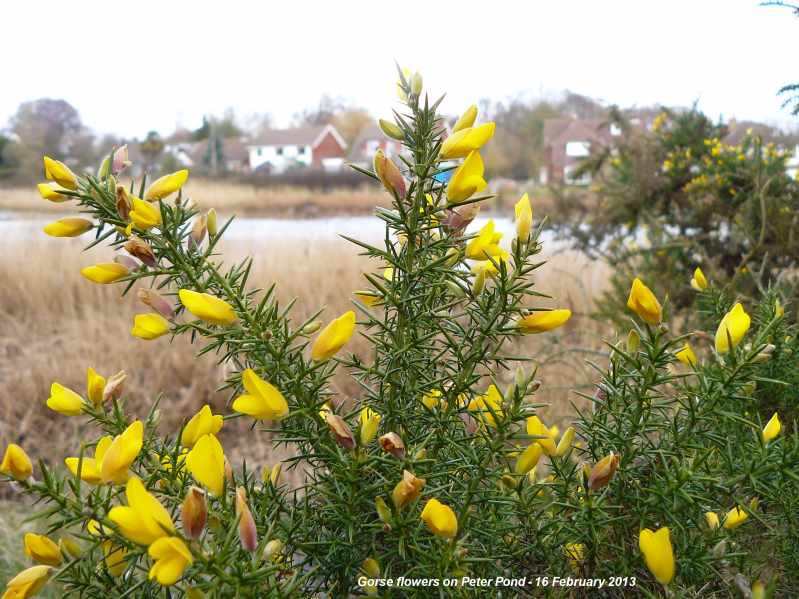
Gorse can be seen
flowering almost throughout the year, which no doubt
gives rise to the saying 'When Gorse is out of bloom,
kissing is out of season'. But it is at its best in
spring and early summer.
Gorse is a member of
the pea family and, looked at closely, its rich golden
yellow flowers have the characteristic five petals
with a standard petal at the top, two wing petals at
the sides and two lower petals forming a boat-shaped
keel. I have opened up a Gorse flower for the
following photo to show these features. The sepals are
also yellow and hairy and one can be seen in the
photo.
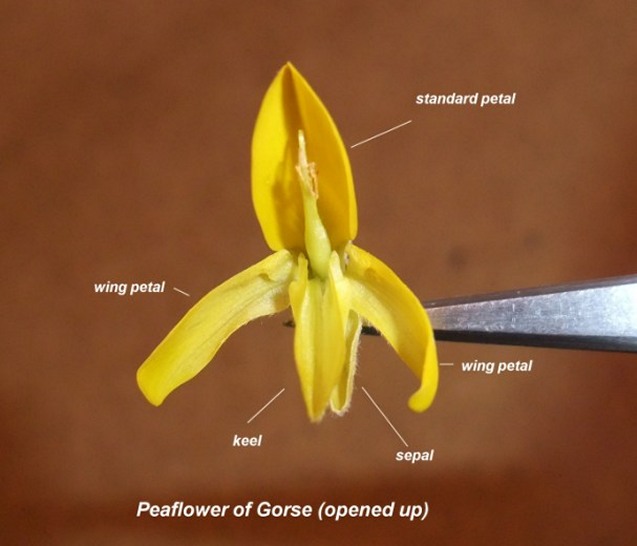
Gorse (Ulex europaeus)
is a native shrub which occurs in under-grazed
pastures, woodland rides, on sea-cliffs and sand
dunes, and on waste ground and railways. It is
sometimes planted as hedges or game-shelter and on
roadsides.
Firecrest
Malcolm Phillips was
back in Emsworth after a few days away, but he found
'his' Firecrest with no difficulty in the usual area
by the observation fence, despite the presence of
crowds of people in the car park for the Country
Market.
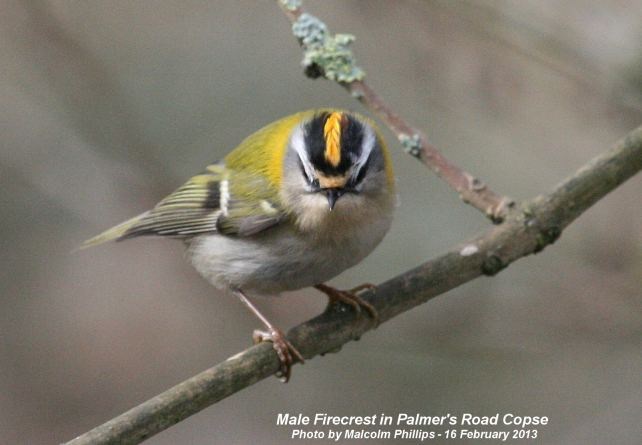
Warblington
walk
Peter Milinets-Raby
did his regular walk along the Warblington Shore this
afternoon starting at 1:30pm. Wigeon and Teal numbers
well down, but that could be due to all the boats
milling about! The highlights were: 4 summer plumaged
Med Gulls at Conigar Point, with 2 more further along
the shore at Pook Lane. 11 Pintail, Greenshank and
Spotted Redshank at Nore Barn. 150+ Dunlin, 10 Little
Egrets in the Pook Lane fields with 5 Stock Doves,
350+ Brent Geese feeding their usual field despite the
huge number of dog walkers.
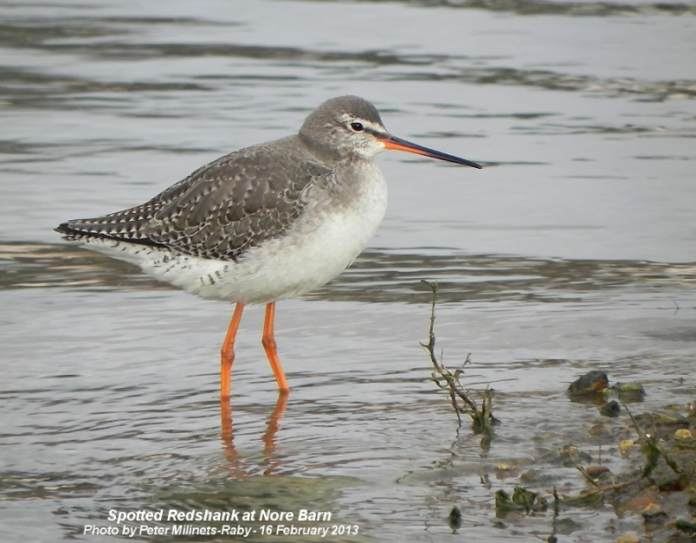
For
earlier observations go to . . February
1-15